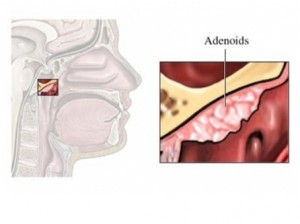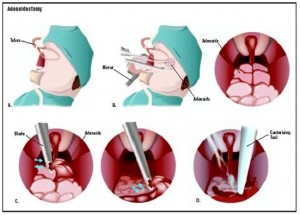Adenoid problems during adenoidectomy are not uncommon, as these parts are prone to infections just like tonsils and are quite sensitive too. Adenoids are lumps of tissues at the back of the throat that fight infections.
Adenoid problems are mainly found only in children as these tissues start disappearing by the time they cross their teenage. The growth of adenoids in humans reaches its peak between the age of three and five. An adenoid removal surgery is advised only when adenoid problems start interfering in a child’s daily life. This can be determined after a proper adenoid diagnosis.

The Basic Adenoid Problems You Might Face
The removal of adenoids is a relatively simple procedure and involves low risk surgery that can take about 15-30 minutes under a general anaesthetic. Some of the adenoid problems that occur during and post surgery are:
-
Bleeding
-
Allergy to Anaesthetic
-
Infections
-
Velopharyngeal Insufficiency
There are some not-so-dangerous adenoidectomy complications as well. Some minor adenoid problems caused due to adenoidectomy are:
-
Sore throat
-
Earache
-
Blocked Nose
-
Change of voice
Most of the adenoid problems can be detected during the recovery period after a tonsil and adenoid removal. Some of the major adenoid removal risks have been explained below.
Adenoid Problems #1 – Bleeding
A child is always kept under observation after the surgery as bleeding is one of the main adenoid problems. Haemorrhage, which is one of the adenoid removal risks, may occur in one among hundred children. In case of bleeding the child may experience coughing and nausea as well.
Immediate medical help should be sought to avoid loss of blood and in rare cases, the child may have to undergo another surgery to stop bleeding. Post operation bleeding is not very common but the doctor should be informed beforehand about bleeding related problems in the family.
Adenoid Problems #2 – Allergy to Anaesthetic
According to the National Institute Of Health, any surgery done under a general anaesthetic does involve some minor problems. The risk is relatively low if the child’s health is in good condition.
The chances of serious allergic reactions cropping up are very low (about 1-20000). Children who are mildly allergic to the anaesthetic may experience some temporary symptoms such as dizziness, nausea and headache. In case of any such reaction the surgeon and anaesthetist involved must be informed.
Adenoid Problems #3 – Infections
Infections are common problems faced after the surgery. Your body will need some time to recover when a part of it is removed. Proper hygiene and caution are of great importance during this time as the place from where the adenoids are removed is susceptible to infections from bacteria.
Body pain and high fever are common problems of infection and antibiotics are prescribed during this time to control the infection. Not exposing your child to any kind of dust, unhygienic or crowded places is of prime importance.
Adenoid Problems #4 – Velopharyngeal Insufficiency
One of the main adenoidectomy complications is velopharyngeal Insufficiency. It is a complication in which liquids and sounds escape through the back of the nose. According to Northwestface Medical and Aesthetic Services, since the palate does not completely seal the back of the throat, speech and swallowing will be affected. This is mainly caused due to the cleft in the palate.

Adenoid Problems #5 – Sore Throat
Sore throat is a common problem faced by children who undergo adenoidectomy. This problem may persist for almost two weeks post surgery. This may cause irritation while swallowing due to swelling. The consumption of normal soft food should help and hot spicy food should be avoided.
Adenoid Problems #6 – Earache
Earache is also one of the post surgical adenoid problems that follow adenoid removal. Since the nerves of the ear and throat are active, there may be some soreness but this does not mean that it is an ear infection. The doctor must be informed so that medicines are given accordingly to ease the pain.
Adenoid Problems #7 – Blocked Nose
The child may experience a temporarily blocked nose after surgery. This will ease by itself in about a week’s time.
Adenoid Problems #8 – Change of Voice
Change of voice is a common problem post surgery. Your child’s voice may seem a bit nasal although this usually settles by itself in a few weeks.
Along with this, the patient may experience bad breath (Halitosis) and also stiffness in the jaw. Though this surgery does not involve any great risk other than bleeding, it may cause some scarring where the adenoids are removed. Some patients may also have their tooth chipped while putting the instrument in the mouth.
Who Should Not Undergo Adenoidectomy
Children who have a cleft in their palate will have a problem as liquids and sounds escape through the back of their nose as the cleft palate is not sealed completely. It is not advisable for such children to undergo this surgery.
Most of these adenoid problems can crop up in a haphazard way and if any of these effects persists for longer than 3-4 weeks, contacting your doctor is the best.